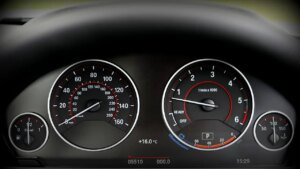Can I Drive with an ABS Warning Light on?
Yes, you can. However, you should get your car checked by a competent mechanic as soon as possible.
ABS (Antilock Braking System) is a vital safety feature that needs to be working effectively. It is there to prevent a car from skidding when braking.
There are five possible reasons why your ABS light is on.
Before we get into the detail, the causes are
- Bad ABS module
- Low Brake fluid
- Faulty Speed Sensor
- Worn Hydraulic Pump
- Blown ABS Fuse
Two causes are cheap fixes, and three are very expensive.
1. Bad ABS Module
There are two reasons why ABS modules go bad.
- Corrosion can take hold in the anti-lock brake system module. This is one of the main reasons why anti-lock brake systems can fail. The module can’t get information from the wheel speed sensor if it is rusted, and this causes the ABS light to come on. This can happen without much corrosion, unfortunately. It should not occur in cars less than ten years old unless it has been driven primarily in humid conditions.
- A cheaper ABS module fix is the wiring. If wires become loose, the signals sent from the wheel speed sensor to the ABS module can be delayed. This can cause the ABS warning light to come on to let you know the ABS may not be as quick to react when you need it.

This is the cheaper fix of the two possible issues with ABS modules.
A fitted new ABS module can cost from $300 up to over $1,000 for prestige cars. Labor costs to fit a new ABS module are only a small of the total bill.
2. Low Brake Fluid
Brake fluid levels can trigger the ABS light. It can happen due to a low fluid level, a leaky seal, or air in your system.
Your ABS module will not evenly balance the brake pressure on each wheel without the correct amount of brake fluid. This can lead to skidding or other problems and poor response times when you need your brakes to react quickly.
A quick check under the hood to see if the brake fluid level isn’t below the minimum will easily rule this out.
Low brake fluid symptoms
Even before you check under the hood, if you have experienced any of the issues below, low brake fluid is likely the cause of the problem.
You may notice a less responsive brake pedal. It may be harder to brake.
Although brake and ABS are independent circuits, your ABS will detect that it can’t operate correctly with low fluid.
Low fluid is the fix that you should be hoping for. Even if there is a leak in the brake fluid circuit, it will be cheaper to fix than a new or repaired ABS module. Dirty brake fluid can also be the culprit.
3. Faulty Speed Sensor
The wheel speed sensor records the speed of your car’s wheels and reports that rate to the electrical control unit (ECU). The ECU also controls your ABS.
The ECU releases brake fluid when one wheel is slower than the other. This allows the car to continue to grip the road.
If the speed sensor doesn’t work, the ECU will not retrieve this data. Your ABS light will then turn on.
Speed sensors are located on the wheels of your car. Most modern vehicles have one on each wheel, located near the front wheels rotors and in the housing of the rear brake assembly on the back wheels.
Speed sensors calculate the wheel’s movement rate. This information is then transmitted to the antilock braking system. The anti-lock brake system will raise the pressure of the brake fluid to let the wheel move at normal speed if at least one of them is slowing down.
All this happens in milliseconds and ensures the right amount of brake is applied to the right wheel at the right time.
The anti-lock brake system will alert you if the speed sensor is not working correctly.
Unfortunately, as these delicate sensors have to be located where dirt and moisture are very common, they are prone to failing.
The cost to replace an ABS wheel speed sensor is $100- $200, with labor costs of $100 per sensor depending on the make and model of your car.
4. Hydraulic Pumps That Are Worn
The wheel speed sensor notifies the anti-lock braking system if one wheel moves slower than the others.
Once this happens, the system will activate the hydraulic pump to increase brake fluid pressure. This will allow the wheels’ traction to be maintained and stabilize the car.
Through a hydraulic pump, the ABS regulates brake fluid pressure. The pump applies brake fluid through a piston to control brakes during standard braking.
Based on the speed reading that the ABS module receives from the speed sensor, the ABS can lower the brake pressure for individual wheels.
This all should work seamlessly in a perfect world. It can all go wrong quickly if the hydraulic pump doesn’t work correctly or the hydraulic valve is damaged.
It is normal for the pumps to wear over time. This can be caused by dirt and metal shavings in your brake fluid. This can be prevented by having your brake fluid tested every time you have your brakes serviced.
These are not cheap parts to replace.
Expect to pay a minimum of $300 for a replacement ABS hydraulic pump and an additional $200 for the labor. This depends on the make and model of your car.
5. Blown ABS Fuse
The ABS is just like other electrical components in your car. It has its own fuse. As fuses can sometimes blow, it’s essential to check the condition of your car fuse box regularly for signs of water leaks.
If you discover that it was, in fact, a fuse that has blown, it is good news and bad news. Replacing a fuse is very quick and cheap, but there is likely to be an underlying problem that has made it blow in the first place.
Of course, replace the fuse, but be aware that if it blows again, it is probably time to get your car checked out, as a problem with the ABS needs to be looked at.
Why Do I Need ABS?
The ABS in your car is designed to slow down your vehicle and possibly even stop it entirely if your tires don’t grip the road properly when you brake. This system is vital for those who drive on slippery roads due to snow, rain, and ice.
If you lose control of your vehicle, the ABS should automatically activate. The ABS will continuously pump the brakes to slow down your car and eventually stop it.
If you are a certain age, you may remember being told to pump the brakes when stopping quickly to avoid skids. Before, all new cars were required to have ABS fitted as standard.
On September 1, 2013, in the US, it became mandatory for all new cars to have ABS fitted as standard. This has been the case in the EU since 2004, almost a decade before.
It is an essential part of your car, and you shouldn’t drive around with the warning light on.
In Conclusion
The ABS light remaining on is never a good thing. The most common causes are low or dirty brake fluid or a faulty speed sensor. Lesser common causes are a blown ABS fuse or a failing ABS module.




![Can Dirty Brake Fluid Cause Squeaky Brakes? [ANSWERED] DOT-3-Brake-Fluid](https://carzaza.com/wp-content/uploads/2023/12/DOT-3-Brake-Fluid-300x161.png)








